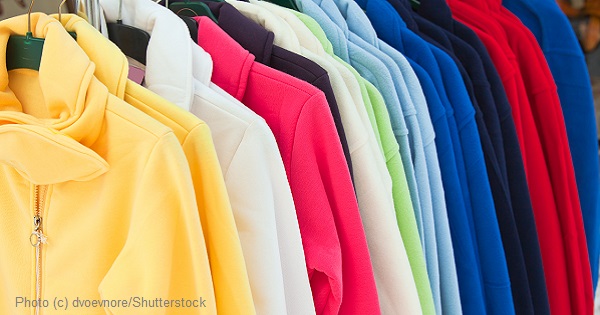|

Microfibers
How Your Clothes Could be Polluting the Oceans
(and damaging your health)
By Wendy Priesnitz
Most of us realize we have created a major problem with plastic in our oceans. Photos appear everywhere these days of birds tangled in fishing line, their beaks trapped shut by plastic packaging, or ingesting bags and other floating plastic.
Ironically, as we’ve tried to solve that part of the plastic pollution problem we’ve created a new, possibly bigger one. A variety of clothing brands, big and small, have been collecting this plastic from the oceans, downcycling it into fibers, and creating clothing. Their efforts are attracting a great deal of positive publicity, and winning them praise for their eco-friendly efforts.
The problem is that when this clothing is washed or discarded, it sheds microplastic fibers, which end up back in the ocean environment. In fact, microfibers are estimated to be responsible for over eighty percent of shoreline pollution around the world. And they’re now showing up in fish and shellfish sold for human consumption, in salt, and in the air and our drinking water. According to the Plastic Pollution Coalition, eighty-three percent of drinking water samples worldwide have tested positive for microscopic plastic fibers.
Microfibers are present in virtually all synthetic fabrics – acrylic, nylon, and polyester. That includes those ever-popular microfiber cleaning and dusting cloths. And every time clothing or other textile products made from these fibers is washed, millions of microfibers are released. Polar fleece from recycled plastic has been found to release the most fiber. But any single synthetic garment can release as many as 1,900 fibres per wash. Since these fibers are too small to be filtered by waste treatment plants, they end up in our waterways.
Back in 2014, we wrote here in Natural Life Magazine about the dangers associated with microbeads in beauty products, and the problems are compounded with microfibers. Aside from the toxicity inherent in this form of plastic, studies show microfibers can absorb other toxins, like pesticides or organic pollutants such as PCBs, and put them into the food chain, eventually ending up on our dinner plates. And now an organization called Five Gyres – one of the main campaigners against microbeads is now also turning its efforts to microfibers.
Things You Can Do
-
Purchase natural fiber clothing, made from cotton, linen, or wool, which eventually break down.
-
Avoid purchasing “fast fashion.”
-
Dust with rags made from non-microfiber materials. (I know: they work well!)
-
Wash synthetic clothes less frequently.
-
Wash a full load, which results in less friction between the clothes and therefore fewer fibers released.
-
Use liquid laundry soap; laundry powder loosens more microfibers.
-
Cold water washing releases fewer fibers than hot water.
-
Use a washing machine with a fiber filter (rare these days) or wash microfiber clothing in a filter bag.
-
Run your dryer at low speed or hang clothes outside to dry.
The best solution is to take a few steps back and stop buying single-use plastic of all kinds. If you think that your purchase of, say, bottled water is justified because the plastic is recycled into new items like clothing, think again. We cannot purchase our way to sustainability.
Wendy Priesnitz is the co-founder and editor of Natural Life Magazine, has been a journalist for over 40 years, and is the author of thirteen books with a few more on the way.
|

